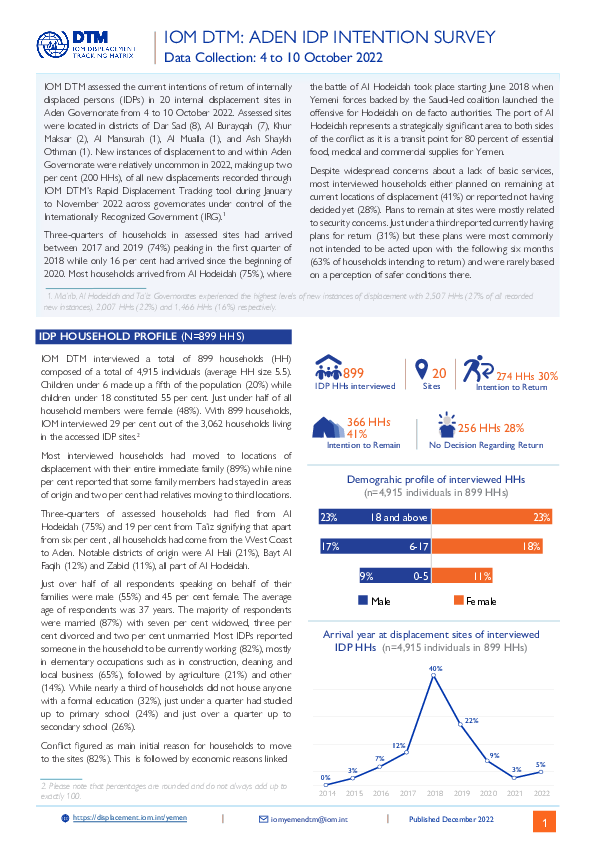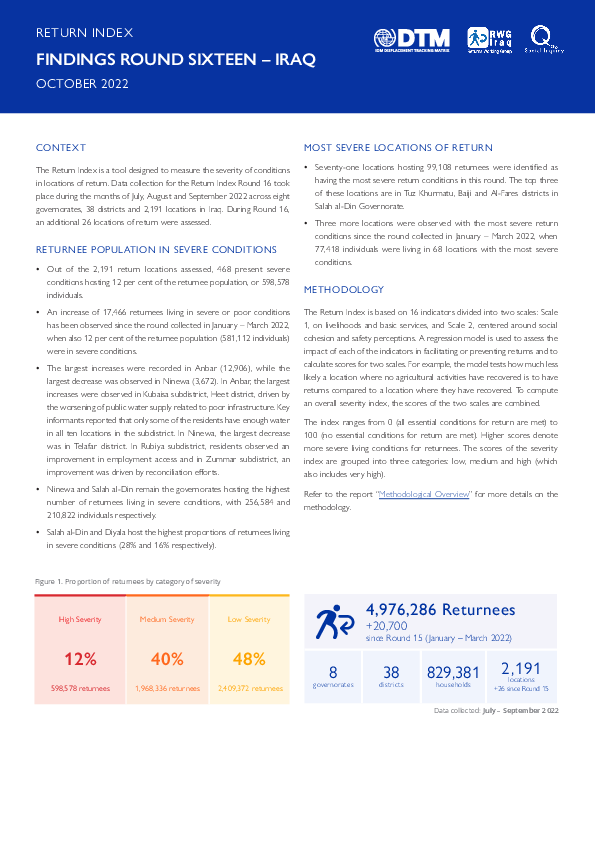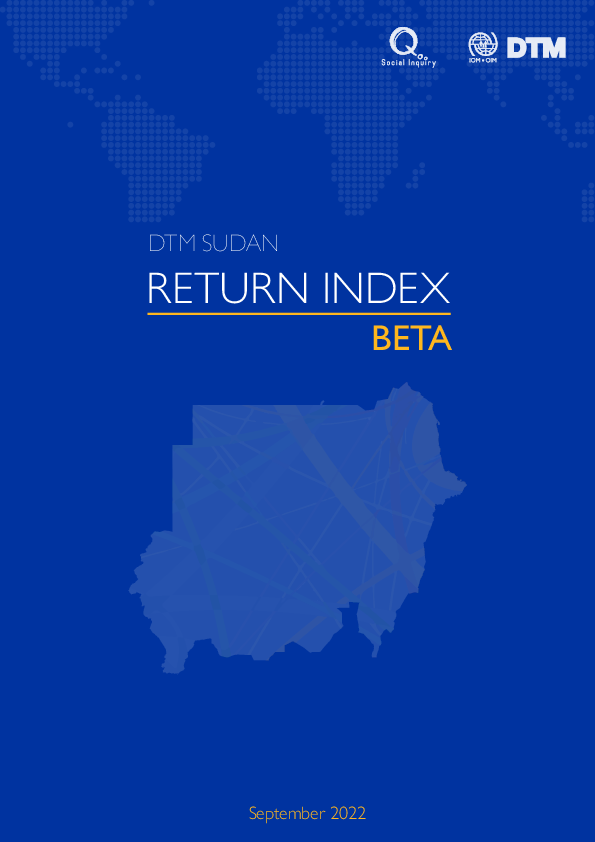-
Countries
-
Data and Analysis
-
Special Focus
-
Crisis Responses
Return Intention

Contact
DTM Europe, DTMMediterranean@iom.int
Language
Ukrainian
Location
Republic of Moldova
Period Covered
Apr 16 2022
Nov 18 2022
Activity
- Survey
- Return Intention
.

Contact
DTM Europe, DTMMediterranean@iom.int
Language
English
Location
Republic of Moldova
Period Covered
Apr 16 2022
Nov 18 2022
Activity
- Survey
- Return Intention
Începând cu 24 februarie 2022, ucrainenii și resortisanții țărilor terțe au plecat din Ucraina în țările vecine ca urmare a războiului din Ucraina. Potrivit Inspectoratului General al Poliției de Frontieră din Republica Moldova, până la 20 noiembrie, la punctele de trecere a frontierei (PTF) au fost înregistrați în total 698.131 de refugiați din Ucraina și resortisanți ai țărilor terțe la intrarea din Ucraina în Republica Moldova. În același timp, au fost raportate și circulații de persoane care au revenit în Ucraina. Potrivit aceleiași surse, 370.918 de cetățeni ucraineni și resortisanți ai țărilor terțe, care au intrat în Republica Moldova, prin toate punctele de control la frontieră începând cu 24 februarie 2022, s-au întors în Ucraina (Sursa: Inspectoratul General al Poliției de Frontieră).
Din aprilie 2022, Organizația Internațională pentru Migrație (OIM) a efectuat prin intermediul CBS Axa Research sondaje cu adulți (18 ani și peste) care au revenit în Ucraina. Sondajul privind întoarcerea în Ucraina face parte din activitățile Matricei de estimare a mobilitatii umane ale OIM, menite să monitorizeze modelele de deplasare, fluxurile și intențiile de deplasare, regiunile de origine și cele mai imediate nevoi ale refugiaților din Ucraina și ale resortisanților țărilor terțe, care au fugit din Ucraina în țările vecine și în alte țări europene începând cu 24 februarie 2022 și care se întorc în Ucraina. Acest raport prezintă o analiză a evoluției profilurilor sociodemografice, a caracteristicilor de călătorie, a regiunilor de origine, a nevoilor umanitare și a intențiilor respondenților de-a lungul timpului, în perioada 16 aprilie - 18 noiembrie. În această perioadă, au fost intervievate 6 173 de persoane, dintre care majoritatea erau cetățeni ucraineni (95%), în timp ce trei la sută erau resortisanți ai țărilor terțe și doi la sută – cetățeni moldoveni. Datele au fost colectate la trei PTF-uri principale din Republica Moldova spre Ucraina: la PTF Otaci (45%), la PTF și centrul de tranzit Palanca (50%), la PTF Tudora (4%). Persoanele care trec frontiera spre Ucraina nu sunt neapărat persoane repatriate, iar eșantionul nu este reprezentativ pentru toate persoanele care intră în Ucraina; prin urmare, rezultatele trebuie considerate doar ca fiind orientative. A se vedea ultima pagină pentru o descriere detaliată ametodologiei.

Contact
DTM Europe, DTMMediterranean@iom.int
Language
English
Location
Poland
Period Covered
Apr 12 2022
Dec 31 2022
Activity
- Survey
- Flow Monitoring Survey
- Return Intention
A total of 8.19 million crossings from Ukraine to Poland were recorded at border crossing points (BCPs) since 24 February 2022 according to Polish Border Guard data from 13 December. IOM’s Displacement Tracking Matrix (DTM) conducted surveys with Ukrainian nationals before they crossed back to Ukraine from three border crossing points in Poland. This report provides an overview of key trends based on the 8,664 surveys that were conducted between 12 April and 31 December 2022 to assess the profiles, needs and intentions of refugees from Ukraine crossing from Poland back into Ukraine. Individuals crossing into Ukraine are not necessarily returnees and conclusions on definitive trends cannot be drawn. The sample is not representative of all persons crossing into Ukraine, results should hence only be considered as indicative.

Contact
DTM Yemen, DTMYemen@iom.int
Language
Arabic
Location
Yemen
Period Covered
Oct 04 2022
Oct 10 2022
Activity
- Survey
- Return Intention
- Mobility Tracking
- Site Assessment
قامت مصفوفة تتبع النزوح التابعة للمنظمة الدولية للهجرة باستطلاع النوايا الحالية فيما يتعلق بعودة الأفراد النازحين داخلياً في 20 موقعاً للنازحين داخلياً في محافظة عدن في الفترة من 4 إلى 10 أكتوبر2022 . تقع المواقع التي تم تقييمها في مديريات دار سعد (8)، البريقة (7)، خور مكسر (2)، المنصورة (1)، المعلا (1)، الشيخ عثمان (1). كانت حالات النزوح الجديدة إلى محافظة عدن وداخلها غير شائعة نسبياً في عام 2022، حيث شكلت 2% ( 200 أسرة) من جميع حالات النزوح الجديدة المسجلة عبر أداة تتبع النزوح السريع التابعة للمنظمة الدولية للهجرة: مصفوفة تتبع النزوح خلال الفترة من يناير إلى نوفمبر 2022 عبر المحافظات الخاضعة لسيطرة الحكومة المعترف بها دولياً.
وصلت ثلاث أرباع من الأسر في المواقع التي تم تقييمها بين عامي 2017 و 2019 (74%) وبلغت ذروتها في الربع الأول من عام 2018 بينما وصلت 16٪ من الأسر فقط منذ بداية عام 2020. وصلت معظم الأسر من الحديده (75%) حيث بدأت معركة الحديدة في يونيو 2018 عندما شنت القوات اليمنية المدعومة من التحالف الذي تقوده السعودية هجوماً على الحديدة في مناطق سلطات الأمر الواقع. يمثل ميناء الحديدة منطقة ذات أهمية استراتيجية لكلا طرفي الصراع حيث يمثل نقطة عبور لـنسبة 80% من الإمدادات الغذائية والطبية والتجارية الأساسية لليمن. وعلى الرغم من المخاوف واسعة الانتشار بشأن نقص الخدمات الأساسية، فإن معظم الأسر التي تمت مقابلتها خططت للبقاء في مواقع النزوح الحاليه(41%) أو ذكرت أنها لم تقرر بعد(28٪). كانت خطط البقاء في المواقع مرتبطة في الغالب بمخاوف أمنية. عبر عدد أقل من الثلث بقليل وجود خطط للعودة (321%) ولكن لم يكن الغرض من هذه الخطط في الغالب أن يتم تنفيذها خلال الأشهر الستة التالية (63٪ ) من الأسر تنوي العوده ونادراً ما كانت تستند إلى تصور للظروف الأكثر أماناً هناك.

Contact
DTM Europe, DTMMediterranean@iom.int
Language
English
Location
Republic of Moldova
Period Covered
Apr 16 2022
Nov 18 2022
Activity
- Survey
- Return Intention
Since 24 February 2022, Ukrainians and Third-Country Nationals (TCNs) have been fleeing from Ukraine to neighbouring
countries as a result of the war in Ukraine. According to the Moldovan General Inspectorate for Border Police, as of 20th
November, a total of 698,131 refugees from Ukraine and TCNs were registered at border crossing points (BCPs) while
entering from Ukraine into the Republic of Moldova. At the same time, movements of persons crossing back to Ukraine
have also been reported. According to the same source, 370,918 Ukrainian nationals and TCNs, who entered into the
Republic of Moldova, from all border control points since 24 February 2022, have exited back to Ukraine (Source: General
Inspectorate for Border Police).
Since April 2022, the International Organization for Migration (IOM) has conducted surveys with adults (18 years and above)
crossing back to Ukraine, through CBS Axa Research. The crossing back survey is part of IOM’s DTM activities that are
meant to monitor the displacement patterns, movement flows and intentions, regions of origin, and most immediate needs
of refugees from Ukraine and TCNs who fled from Ukraine into neighbouring countries and other European countries since
24 February 2022 and are crossing back into Ukraine.
This report presents an analysis of the evolution of respondents’ sociodemographic profiles, travel characteristics, regions of
origin, humanitarian needs and intentions over time, during the covered period of 16 April and 18 November. During this
period, 6 173 individuals were interviewed, most of whom were Ukrainian citizens (95%) while three per cent were TCNs
and two per cent were Moldovan nationals. Data was collected at three main BCPs from the Republic of Moldova to
Ukraine: at Otaci BCP (45%), at Palanca BCP and Transit centre (50%), at Tudora BCP (4%). Individuals crossing into
Ukraine are not necessarily returnees and the sample is not representative of all persons crossing into Ukraine, results
should hence only be considered as indicative.

Contact
DTM Yemen, iomyemendtm@iom.int
Language
English
Location
Yemen
Period Covered
Oct 04 2022
Oct 10 2022
Activity
- Survey
- Return Intention
- Mobility Tracking
- Site Assessment
IOM DTM assessed the current intentions of return of internally displaced persons (IDPs) in 20 internal displacement sites in Aden Governorate from 4 to 10 October 2022. Assessed sites were located in districts of Dar Sad (8), Al Burayqah (7), Khur Maksar (2), Al Mansurah (1), Al Mualla (1), and Ash Shaykh Othman (1). New instances of displacement to and within Aden Governorate were relatively uncommon in 2022, making up two per cent (200 HHs), of all new displacements recorded through IOM DTM’s Rapid Displacement Tracking tool during January to November 2022 across governorates under control of the Internationally Recognized Government (IRG).
Three-quarters of households in assessed sites had arrived between 2017 and 2019 (74%) peaking in the first quarter of 2018 while only 16 per cent had arrived since the beginning of 2020. Most households arrived from Al Hodeidah (75%), where the battle of Al Hodeidah took place starting June 2018 when Yemeni forces backed by the Saudi-led coalition launched the offensive for Hodeidah on de facto authorities. The port of Al Hodeidah represents a strategically significant area to both sides of the conflict as it is a transit point for 80 percent of essential food, medical and commercial supplies for Yemen.

Contact
DTM Europe, DTMMediterranean@iom.int
Language
English
Location
Republic of Moldova
Period Covered
Oct 06 2022
Nov 18 2022
Activity
- Survey
- Return Intention
Since the invasion of Ukraine by the Russian Federation on 24 February 2022, people have been fleeing from Ukraine to the neighbouring countries in high numbers. As of 17 November 2022, 695,159 refugees and Third-Country Nationals (TCNs) from Ukraine were registered at border crossing points (BCPs) entering the Republic of Moldova. Simultaneously, movements of persons crossing back to Ukraine have been reported. According to national authorities, 200,400 Ukrainian nationals and TCNs who entered the Republic of Moldova from Ukraine after 24 February 2022, have since then travelled back (Source: General Inspectorate for Border Police). The International Organization for Migration (IOM) has conducted surveys with adults (18 years and above) crossing back to Ukraine, through CBS Axa Research, since April 2022. Data is collected at two main border crossing points (BCPs) with Ukraine – Palanca and Otaci. This report presents the main findings based on data collected between 6 October and 18 November 2022. Individuals crossing into Ukraine are not necessarily returnees and conclusions on definitive trends cannot be drawn. The sample is not representative of all persons crossing to Ukraine, and results should only be considered as indicative

Contact
DTM DRC, iomdrcdtm@iom.int
Language
French
Location
Democratic Republic of the Congo
Period Covered
Nov 01 2022
Nov 30 2022
Activity
- Survey
- Return Intention
- Registration
- Mobility Tracking
- Site Assessment
De violents combats ont éclaté dans l'est de la République démocratique du Congo entre les rebelles du M 23 et les forces gouvernementales ( en novembre 2021 rompant une trêve qui durait depuis plusieurs années sur les lignes de front entre ces forces Cette situation a conduit à des violences depuis la reprise des combats en mars 2022 entraînant une urgence humanitaire et le déplacement de plus de 370 000 personnes ETT 104 au mois de novembre 2022.
Ces personnes déplacées quittent leurs villages d'origine pour échapper à la violence et aux attaques armées du groupe, abandonnant tous leurs moyens de subsistance, pour chercher une protection dans des endroits qu'elles considèrent comme sûrs Cette population déplacée a trouvé refuge à la fois dans des communautés d'accueil et des centres collectifs dans les territoires de Rutshuru, Lubero et Nyiragongo 99 centres collectifs ont été ouverts et accueillent des personnes vulnérables qui ont besoin d'une assistance humanitaire immédiate pour survivre En réponse à ce contexte, l'Organisation Internationale pour les Migrations ( a mis en place la matrice de suivi des déplacements (Displacement Tracking Matrix DTM) afin de collecter des données fiables auprès des populations affectées dans les centres collectifs du territoire de Nyiragongo, incluant le nombre, les profils, les schémas de déplacement, les conditions de vie et les vulnérabilités, afin de fournir des informations pour faciliter une réponse humanitaire Ces opérations d'enregistrement ont été menées en collaboration avec la Division des Affaires Humanitaires (DIVAH Nord Kivu) avec le soutien opérationnel du Norwegian Refugee Council (NRC).
L'équipe DTM de l'OIM continuera à adapter son approche opérationnelle afin d'approfondir la compréhension globale de cette crise et de son impact direct et à plus long terme sur les populations mobiles par le biais des activités suivantes le suivi des situations d'urgence ( la collecte des intentions et l'enregistrement ainsi que le suivi continu des tendances des déplacements avant, pendant et après les crises, afin de fournir une base de d’information probante pour la planification, la programmation et l’intervention humanitaires

Contact
DTM Iraq, IraqDTM@iom.int
Language
English
Location
Iraq
Period Covered
Jul 01 2022
Sep 30 2022
Activity
- Survey
- Return Intention
- Mobility Tracking
- Baseline Assessment
The Return Index is a tool designed to measure the severity of conditions in locations of return. Data collection for the Return Index Round 16 took place during the months of July, August and September 2022 across eight governorates, 38 districts and 2,191 locations in Iraq. During Round 16, an additional 26 locations of return were assessed.

Contact
dtmsudan@iom.int
Language
English
Location
Sudan
Period Covered
Dec 15 2021
Jan 16 2022
Activity
- Return Intention
- Mobility Tracking
To address a gap in information on the conditions in which permanent returnees are living across Sudan, which makes difficult to understand why IDPs return to some areas and not others or, put another way, what makes some locations more conducive to voluntary return than others, IOM DTM designed the first ever (beta version) Return Index for Sudan.
Sudan Return Index Beta evaluates the material and social living conditions in locations of return in Sudan based on a common and comparable value. This tool shows that locations with better conditions are also more conducive to having returnee populations. The Return Index can be used to infer what conditions are most critical for facilitating returns, how to address obstacles, where to geographically target interventions and advocacy, how to strategize for resources and operations, and to explore changes in conditions over time.
The tool provides a means of measuring the severity of living conditions in locations of returns by combining first, a collection of context informed minimum or critical living conditions that are necessary to make a location adequate enough to sustain returning populations; and second, quantitative analysis to generate and apply an index score to each location based on the state of these indicators.
Pagination
- Previous page
- Page 14
- Next page
